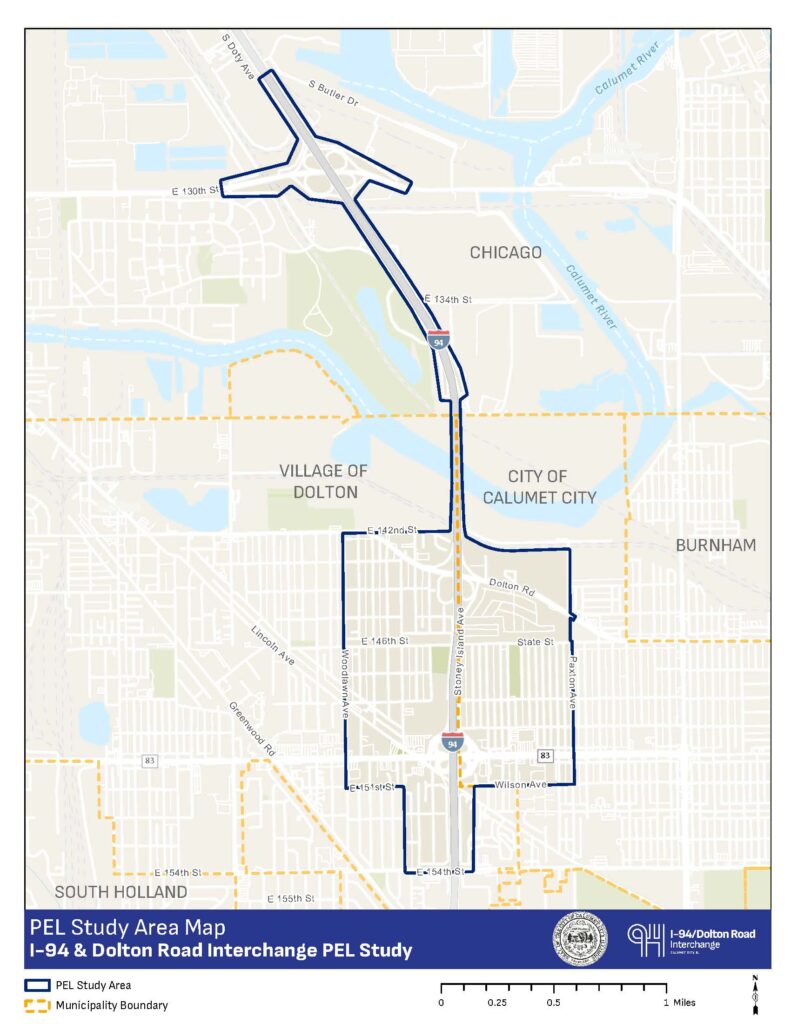I-94 & Dolton Road Interchange PEL Study
We are working with the Illinois Department of Transportation (IDOT) – Bureau of Local Roads and Streets (BLRS) and the U.S. Federal Highway Administration (FHWA) to evaluate Dolton Road and Interstate 94 (also known as Bishop Ford Expressway) through the 18-month I-94 & Dolton Road Interchange Planning and Environment Linkages (PEL) Study.
This study will:
- Identify community needs and challenges of traveling through the project area, including full interchange access, safety, roadway deficiencies, and mobility/connectivity;
- Identify and screen potential solutions, known as alternatives, to address community needs at the interchange that IDOT and the City of Calumet City may move forward for further evaluation and study;
- Assess ecology and natural resources, community and social resources, equity and inclusion of historically underserved populations, economic development, parks and recreation, historic and archaeological resources, visual resources, land use, floodplains, soils and geology, regulated waste, tribal and cultural resources, vegetation, floodplains, water resources, wetlands, and water quality.
- Engage public stakeholders and resource agencies early and throughout the process.
Comment on the PEL Study!
We’re studying the interchange at I-94 and Dolton Road. Your feedback is important for shaping this study.
Please enter your questions or comments below — Now is the time to comment!
What Are We Studying?
Existing conditions of the interchange provide partial access to and from the Bishop Ford Expressway. The PEL study assesses the need for providing full access at this interchange and what solutions would be best, considering the public, neighbors, traffic needs, safety, the community, environmental resources, and more.
What is a PEL Study?
Federal Planning and Environment Linkages (PEL) studies use a collaborative and integrated approach that considers how a transportation improvement project may benefit or impact the environment, community and economy within a study area.
A PEL study can improve information sharing blends early planning studies with aspects of the environmental review process (such as agency coordination.) It provides opportunities for Federal review so the planning study work can be brought into the National Environmental Policy Act (NEPA) process during the next phase of transportation planning.
Projects with a Federal link (such as federal funding or a federal permit) require environmental review under NEPA. NEPA is a Federal law that follows a formal environmental review process to ensure a project remains in compliance with various federal, state, and local laws and regulations.
PEL allows for early “planning-level” discussions with the community, stakeholders as well as resource and regulatory agencies.
These discussions will help to:
- Define the project location.
- Develop a well-defined Purpose of and Need for a project.
- Develop reasonable alternatives for subsequent NEPA analysis.
These are all essential elements of the NEPA decision-making process.
Study Overview & Timeline
NOW is the time to engage with us!
The collaborative and integrated approach of a PEL study allows us to go through the study’s process together from beginning to end, while presenting the public with information and listening to your feedback. Successful community engagement in a PEL study will mean that all of those impacted by the interchange – both directly and indirectly – will have ample opportunity to tell us what you think about the interchange’s challenges, the data that we collect, and potential solutions for improving quality of life as we access and navigate this cross section of major roadway.
This process is data-driven, utilizing information, analysis, and products developed during the planning and environmental review processes. Similarly, data will guide us in identifying and engaging with the community, ranging from vocal leaders to historically underserved groups such as low-income and minority populations, the young and old, individuals facing digital communication barriers, job seekers, small business owners, and non-native English speakers, among others.
The goal is to arrive at alternatives that incorporate transportation equity and address the needs of the underserved communities along the proposed project area.
The Engagement Team will accomplish this goal:
- First, through a talented and diverse staff that represents the study’s regional community. This approach will enable us to seriously consider different perspectives and challenges to ensure our strategy meets the needs of the community.
- Second, by bringing together key members of the public through:
- In-person and virtual Public Information Meetings (PIMs);
- Economic & Workforce Development Workshops;
- Stakeholder Advisory Committee (SAC) meetings;
- Third, by publishing key study information through:
- Newsletters
- The project’s website
- On social media platforms
- And last, seeking, collecting, and responding to public comments through:
- Public legal notices and advertising
- Mailings
- Surveys
Join the Stakeholder Advisory Council!
Key representatives from the community make up the Stakeholder Advisory Council (SAC,) an important contingency to the PEL study that ensures continued engagement throughout the process. The purpose of the SAC is to provide input on the community needs, concerns, and values and to act as a conduit between the engagement team and the community.
The Council includes stakeholder groups such as:
- Public officials (or appointees)
- Businesses
- Nonprofits
- Seniors
- Youth and advocacy
Want to join the SAC? The SAC is a volunteer council that works with the study’s engagement team to help ensure that information in the study is disseminated throughout the community. We will meet up to 12 times throughout the study, both virtually and in-person. We would like your recommendation, if you have any, for possible SAC members. Please email Tracey Bailey at Tbailey@BSquaredCG.com.
Project Documents
Presentations
Stakeholder Meeting #1
March 26, 2024
Stakeholder Meeting #2
April 23, 2024
Stakeholder Meeting #3
May 21, 2024
Stakeholder Meeting #4
July 2024
Workshop Presentation
August 7, 2024
Existing Conditions Display Boards
July 2024
Public Information Meeting Handout
July 2024
Workshop Agenda
July 7, 2024


